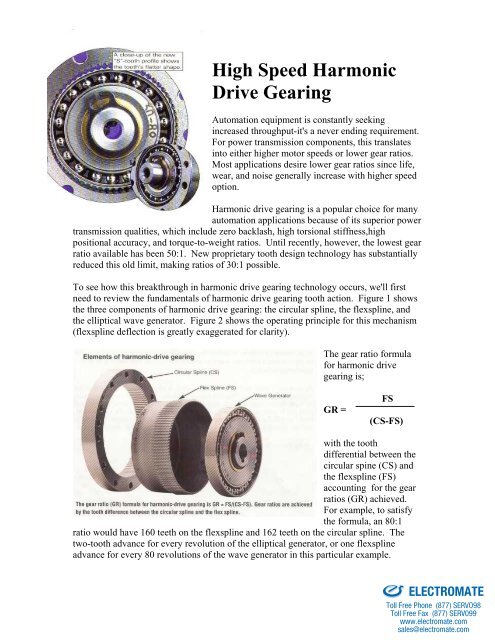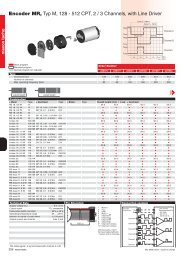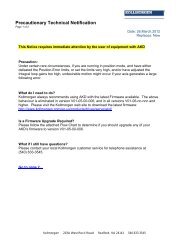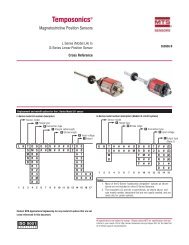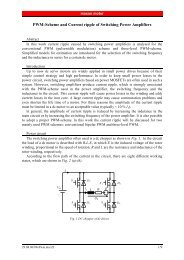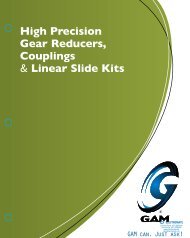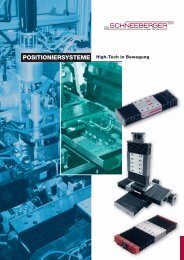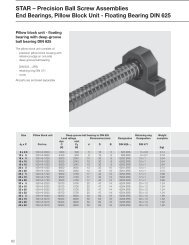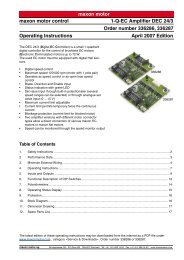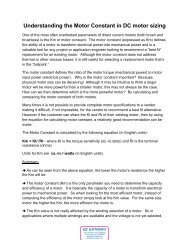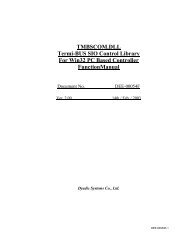High Speed Harmonic Drive Gearing - Electromate Industrial Sales ...
High Speed Harmonic Drive Gearing - Electromate Industrial Sales ...
High Speed Harmonic Drive Gearing - Electromate Industrial Sales ...
Create successful ePaper yourself
Turn your PDF publications into a flip-book with our unique Google optimized e-Paper software.
<strong>High</strong> <strong>Speed</strong> <strong>Harmonic</strong><br />
<strong>Drive</strong> <strong>Gearing</strong><br />
Automation equipment is constantly seeking<br />
increased throughput-it's a never ending requirement.<br />
For power transmission components, this translates<br />
into either higher motor speeds or lower gear ratios.<br />
Most applications desire lower gear ratios since life,<br />
wear, and noise generally increase with higher speed<br />
option.<br />
<strong>Harmonic</strong> drive gearing is a popular choice for many<br />
automation applications because of its superior power<br />
transmission qualities, which include zero backlash, high torsional stiffness,high<br />
positional accuracy, and torque-to-weight ratios. Until recently, however, the lowest gear<br />
ratio available has been 50:1. New proprietary tooth design technology has substantially<br />
reduced this old limit, making ratios of 30:1 possible.<br />
To see how this breakthrough in harmonic drive gearing technology occurs, we'll first<br />
need to review the fundamentals of harmonic drive gearing tooth action. Figure 1 shows<br />
the three components of harmonic drive gearing: the circular spline, the flexspline, and<br />
the elliptical wave generator. Figure 2 shows the operating principle for this mechanism<br />
(flexspline deflection is greatly exaggerated for clarity).<br />
The gear ratio formula<br />
for harmonic drive<br />
gearing is;<br />
GR =<br />
FS<br />
(CS-FS)<br />
with the tooth<br />
differential between the<br />
circular spine (CS) and<br />
the flexspline (FS)<br />
accounting for the gear<br />
ratios (GR) achieved.<br />
For example, to satisfy<br />
the formula, an 80:1<br />
ratio would have 160 teeth on the flexspline and 162 teeth on the circular spline. The<br />
two-tooth advance for every revolution of the elliptical generator, or one flexspline<br />
advance for every 80 revolutions of the wave generator in this particular example.<br />
Sold & Serviced By:<br />
ELECTROMATE<br />
Toll Free Phone (877) SERVO98<br />
Toll Free Fax (877) SERV099<br />
www.electromate.com<br />
sales@electromate.com
<strong>Harmonic</strong> drive gears operate by engaging multiple teeth at the major axes while<br />
disengaging them at the minor axes of the wave generator ellipse. To minimize flex<br />
stress in the flexspline, our goal is to keep ellipicity to a minimum, which leads us to<br />
small tooth height. Achieving a 50:1 ratio, for example, means producing a 100-tooth<br />
circular spline. As the number of teeth decreases, their size increases; consequently,<br />
ellipicity must increase to provide the required clearance at the minor axis. In older<br />
designs, ratios below 80:1 more often than not made use of a four-tooth difference,<br />
usually doubling the number of teeth to 200 for a 50:1 ratio in order to reduce the tooth<br />
size. Achieving a ratio of approximately 30:1 meant changes in the tooth design were<br />
required.<br />
HD Systems introduced the "S"-tooth design in 1991. This profile, a departure<br />
from the old involute-tooth form, brought many advantages to harmonic drive gearing,<br />
such as increased torque capacity, stronger teeth, longer life, and higher torsional<br />
stiffness. Figure 3 shows the "S"-tooth profile and the relative motions of the flexspline<br />
and circular spline in operation. Developing the new tooth form required significant<br />
design analysis, resulting in a profile that lets high numbers of teeth in simultaneous<br />
contact share in carrying the load while keeping a low ellipticity. This "S"-tooth profile<br />
brought another benefit to harmonic drive gearing by permitting a reduction in ratio down<br />
to 50:1, using the two-tooth difference.<br />
Nonetheless, getting 30:1 ratios with a two-tooth difference required further<br />
profile modifications. In the past, the axisymmetric nature of harmonic drive gearing<br />
permitted the use of two-dimensional modeling, which was sufficient to study the<br />
kinematics and stress distribution for ratios of 50:1 and higher. However, the demands of<br />
30:1 ratios required a degree of modeling sophistication that two-dimensional models<br />
could not deliver. We developed a complex three-dimensional simulation of tooth<br />
engagement so that parameters of the "S"-tooth profile could be studied, examined, and<br />
modified for optimum engagement and minimum wear. This procedure included detailed<br />
finite element analysis of the flexspline toothbed, identifying high stress areas and<br />
allowing design modifications for reducing stress to safe and reliable limits.<br />
Sold & Serviced By:<br />
ELECTROMATE<br />
Toll Free Phone (877) SERVO98<br />
Toll Free Fax (877) SERV099<br />
www.electromate.com<br />
sales@electromate.com
Figure 4 shows the new "S"-tooth (for 30:1) action in the circular-spline/flexspline<br />
interface.<br />
The result is a new profile that permits 30:1 gear ratios using the two-tooth<br />
difference, minimizing ellipticity and maintaining low flexspline stresses. In addition,<br />
this new "S"-tooth profile still provides all of the benefits of "S"-tooth harmonic drive<br />
gearing. This technology can be incorporated into the complete into the complete range<br />
of products, including component sets, gearheads, and servo actuators. With the new<br />
lower ratios available, harmonic drive gearing may now be used in applications where<br />
planetary or other low-ratio gears might have been used previously, thus allowing a<br />
reduction in package size and weight while increasing positional accuracy and achieving<br />
zero backlash. This new tooth profile is a major step forward in expanding the range of<br />
applications suitable for harmonic drive gearing and in addressing industry's need for<br />
increased throughput and accuracy.<br />
Sold & Serviced By:<br />
ELECTROMATE<br />
Toll Free Phone (877) SERVO98<br />
Toll Free Fax (877) SERV099<br />
www.electromate.com<br />
sales@electromate.com


